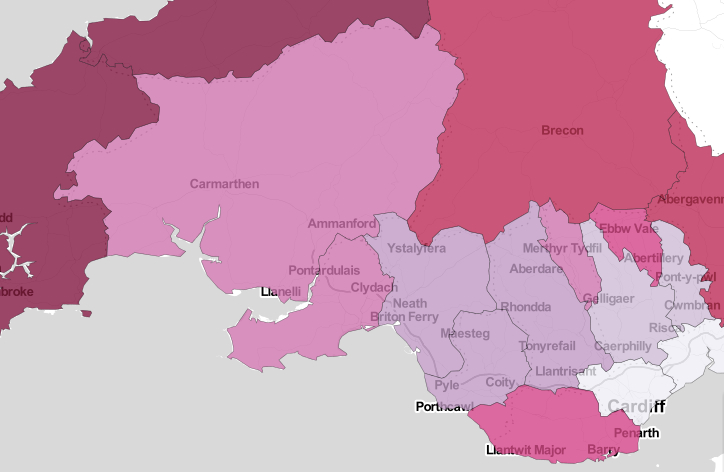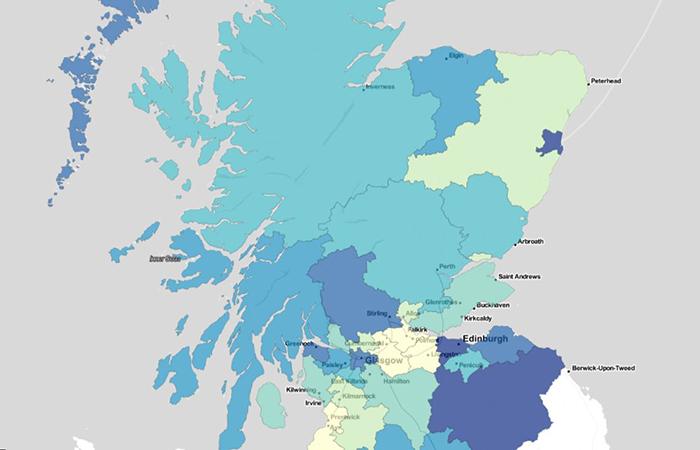How can places make the most of their heritage? Jonathan Schifferes introduces the 2016 Heritage Index, a collaboration with the Heritage Lottery Fund.
Last year we set out to answer a difficult question, using a data-led approach.
Our research has shown that heritage is a key resource to connect people to places. Strengthening that connection brings to places as host of other social and economic benefits. So the next logical question is how much of this resource do we have locally?
Today we release our updated Heritage Index. The scale and breadth of what our team has pulled together is astounding, covering 120 indicators, with local data available for all 390 local authority areas in the UK’s four nations. We want people to give people a richer understanding of their place, so that they are inspired to get involved in shaping their place into the future.
Heritage Index 2016 covers 120 indicators and draws upon local data available for all 390 local authority areas in the UK’s four nations
You’ll be inspired by some of the less famous places in the Top 10 (including Scarborough, Gosport and Norwich), but look closer to home and you’ll discover the heritage on your doorstep, including industrial heritage, natural heritage and cultures and memories. Once you explore the maps and data, you’ll never think of heritage in the same way again.
In summer 2015 we first set out to measure the strength of heritage at the local level. We started to organise existing data covering both heritage assets (material and tangible stuff like buildings and nature reserves) and heritage activities (things like volunteering, investment and community initiatives). We’ve take a broad and inclusive view of how you measure heritage. We’ve combined data on the UK’s 10,000 blue plaques, through to size of ancient woodland and the number of local foods with protected naming status (like Cornish pasties).
In short, we wanted to reflect in our data what we were hearing at our workshops and events up and down the UK – heritage is a matter not just of what you have but what you do with it, and it’s up to citizens to decide: heritage is what you choose to make it.
Since our first Heritage Index was released last year, we’ve been amazed by how people have responded.
- Over 50,000 people have browsed our maps to see how their area performs.
- Over 1,000 people have downloaded the raw data for themselves, using it for their neighbourhood plan, for funding applications or to teach young people about the local area.
- We’ve been to dozens of towns and cities, speaking at events organised by our network of RSA Heritage Ambassadors. And since March the Heritage Index has been adopted as an official performance measure in England, through the government’s recent Culture White Paper.
This year, the Heritage Index is bigger and better. We’ve got new data from the Woodland Trust on 140,000 ancient trees across the UK; 65,000 war memorials documented by the Imperial War Museum; 6,000 shipwrecks off the coast compiled by Historic England; and data from the National Trust detailing 400 square miles of open access land. And, importantly, we’ve got an up to date picture on heritage activities at the local scale – from thousands of Heritage Open Days, through to clubs and groups for young people to enjoy wildlife and appreciate archaeology.
Heritage and identity are intimately linked, and our research shows this link is strongest in places where the public contribute and lead. It is through strong networks – what we call ‘networked heritage’ that the value of these contributions is maximised.
The Heritage Index is a tool to explore place. It has brought people together and strengthened networks. Let us know how your place uses it to plan for the future.
Explore the 2016 Heritage Index
Top 10 Heritage places - overall
|
ENGLAND |
NORTHERN IRELAND |
SCOTLAND |
WALES |
|
1. City of London |
1. Belfast
|
1. Orkney Islands
|
1. Gwynedd |
|
2. Kensington and Chelsea |
2. Ards and North Down
|
2. Dundee City |
2. Monmouthshire
|
|
3. Westminster
|
3. Newry, Mourne and Down |
3. Eilean Siar |
3. Powys
|
|
4. Scarborough |
4. Causeway Coast and Glens |
4. Shetland Islands
|
4. Ceredigion
|
|
5. West Somerset |
5. Fermanagh and Omagh |
5. City of Edinburgh |
5. Cardiff
|
|
6. South Lakeland |
6. Mid Ulster |
6. Argyll and Bute
|
6. Conwy
|
|
7. Gosport
|
7. Lisburn and Castlereagh |
7. East Lothian |
7. Pembrokeshire
|
|
8. Oxford
|
8. Mid and East Antrim |
8.West Dunbartonshire |
8. Denbighshire
|
|
9. Norwich |
9. Antrim and Newtownabbey |
9. Stirling |
9. Merthyr Tydfil
|
|
10. Weymouth and Portland |
10. Derry City and Strabane |
10. Highland
|
10. Isle of Anglesey
|
Related articles
-
Could the future of Heritage in Grimsby be wind powered?
Jake Thorold
In Grimsby, fishing heritage can work alongside wind energy in pursuit of economic rejuvenation.
-
Cultural Boost for South Tyneside
Iain Malcolm
Iain Malcolm, Leader of South Tyneside Council reflects on the impact of the RSA's Heritage Index a year on.
-
A Heritage boost for Maidstone
Nick Ewank
The 2016 Heritage Index is out … and Maidstone has leapt up the table, rising 54 places to enter the top half of the league.




Join the discussion
Comments
Please login to post a comment or reply
Don't have an account? Click here to register.
I’m a new Fellow; this is my first contribution. At theoutset may I say that this kind of debate is exactly what I hoped to get from joining?This study, and the reaction to it, pulls into sharp relief the potentialdissonance between a town’s or region’s heritage identity and the image thatothers have of it. Gosport, for example, scores highly for heritage in thisstudy, but few would describe the borough or the town as a heritagedestination. Winchester, just up the road, is a very definite heritagedestination, but scores less highly. Yet Winchester wishes it could achievewhat Gosport has achieved in attracting recent developments in technologicaland engineering education and innovation. Does Gosport wish for itself whatWinchester has achieved in being known as a heritage destination? It would becrass to suggest that a community that identifies mainly with its heritage isnot necessarily attractive to external, forward-looking innovation, but I thinkwe should take very deliberately any decision to properly promote our localheritage identity as a wider heritage image; this is a question thatSouthampton City Council has wrestled with for decades. This study is a digestof existing data and is therefore only as useful as the data upon which it isformulated; we are entitled to take a view on whether those data represent ourown reality. My view is that this study is what it is - it has clearly provokedus and is a powerful opening gambit to a debate - but we can be assured that itneed not have any impact on tactical and strategic decisions made at locallevel. Communities, when properly organised and mobilised, are more powerfulthan data. It’s up to us.
I do think it is rather important that this is seen as a pilot, with the intention of getting the data properly verified and in some cases the categories adjusted, and not as a device for grabbing (spurious) headlines. Perhaps the Fellowship could assist with this? The value of the exercise is really that by providing comparative statistics it gives a means for local citizens to call the policy makers in their areas to account. It will be futile if it turns into a tussle between those who wish to 'rubbish' the whole idea of trying to assess the value of local heritage assets as a basis for serious discussion about safeguarding and developing them, and those who will seize on such results to generate "League Tables" to grab tabloid headlines without regard for the harm done.
May I illustrate? I am a member of the Council of the Derby Civic Society, however Derby is listed as not having any such organisation. (The source for this information appears to be Civic Voice which has actually been sending us things quite recently !) Derby appears to fare not too badly in relation to "Museums, Archives and Artefacts" but close inspect suggests something is seriously amiss with the nature of the data you are using.
The capital value of the publicly owned assets is stated to be £0, but actually there is a range of important buildings (e.g. Grade I, World Heritage, etc) which are in the ownership of the Local Authority, though they are run by an independent Museums Trust. I'm not sure how many tens millions of pounds worth of heritage assets these buildings constitute, but the combined amount will be swamped by the value of just one of the Museum's collections - viz. the Joseph Wright collection, which is recognised as being of international significance. The collection as a whole isn't "owned" by the Trust, but it is not something that the Local Authority could try to sell without breach of Trust. While Derby seems to have done quite well in this section because of just shy of £10M HLF funding, the actual value of the heritage assets to which this section relates runs into hundreds of millions. (They need safeguarding and they need recognising as something Derby has to offer to the wider world. I am quite certain this is true of many other places as well.)
It also appears that because there is an independent Museums Trust which earns income (rather that the Local Authority doing so), it appears there is no revenue being generated by these heritage assets.
The sources for data like this need reconsidering, but an exercise like this has to be potential to be a very useful tool for a local Civic Society (assuming one actually exists !) to challenge local policies and guide what happens in its locality,
I was very critical of this exercise last year and remain so. You can drive a 'coach and horses' (to use a heritage term) through this data. Thie idea of coming up with league tables on this is flawed and comparing London with say the borough of St Helens is just ludicrous. Just take one example of the town of Prescot. In the 16th and 17th century bigger than Liverpool, hosted Shakespeare in the north, one of the oldest schools in the country, the Parish Church history, the home of clock and watchmaking etc. To drop that town into the bottom 1% - surely the researchers on this project should be hearing the alarm bells. This is flawed so I am with other colleagues below this needs a review by the RSA as it is not a good exercise - drop the league tables and scoring.
Thanks, Nick. Wholeheartedly agree.
I agree with Steb and Graham. The concept of ranking areas is unhelpful. Information is helpful both to people in a particular area and those who visit. Percentages are not helpful - and what is a local authority to do about, say, a lack of 'industrial heritage'? Governments over the last 20 years have been obsessed with tables and rank order; has that been a good thing? Applying it to heritage does not seem the wisest approach.
Totally agree. Apart from having serious misgivings about the accuracy of the data and the metrics used, our apparently impoverished area (which is not at all exceptional in the richness of its 'lower 7%' heritage factor) has just fought, and achieved a temporary stay of execution from, developers who planned on building a 5000 house new town "that would have no impact on the village". Giving them data like this spurious heritage survey to quote is going to be Manna from Heaven.
As an Australian, born in the London, I think that this is the most wonderful project. Congratulations to all involved. I will be contacting friends here to see if something similar might be created. We have more than 40,000 years of heritage to collect.
The only misgiving I have is that of ranking locations and communities. Identity is not something to be ranked, but simply enjoyed and celebrated.
Thank you Steb, be sure to keep us in the loop as your plans progress! (https://www.thersa.org/about-us/staff/profiles/adanna-shallowe)
Rankings have their downsides, I appreciate that. We're not ranking the strength of identity - others have measured well-being and other subjective sentiment. I guess any national data exercise with a local component invites local vs. local comparisons. We've made that explicit in how we have published the data, and I would point out that it has compelled a few places to take action, identifying and realising opportunities to make the most of their heritage (https://www.thersa.org/discover/publications-and-articles/rsa-blogs/2016/11/cultural-boost-for-south-tyneside).